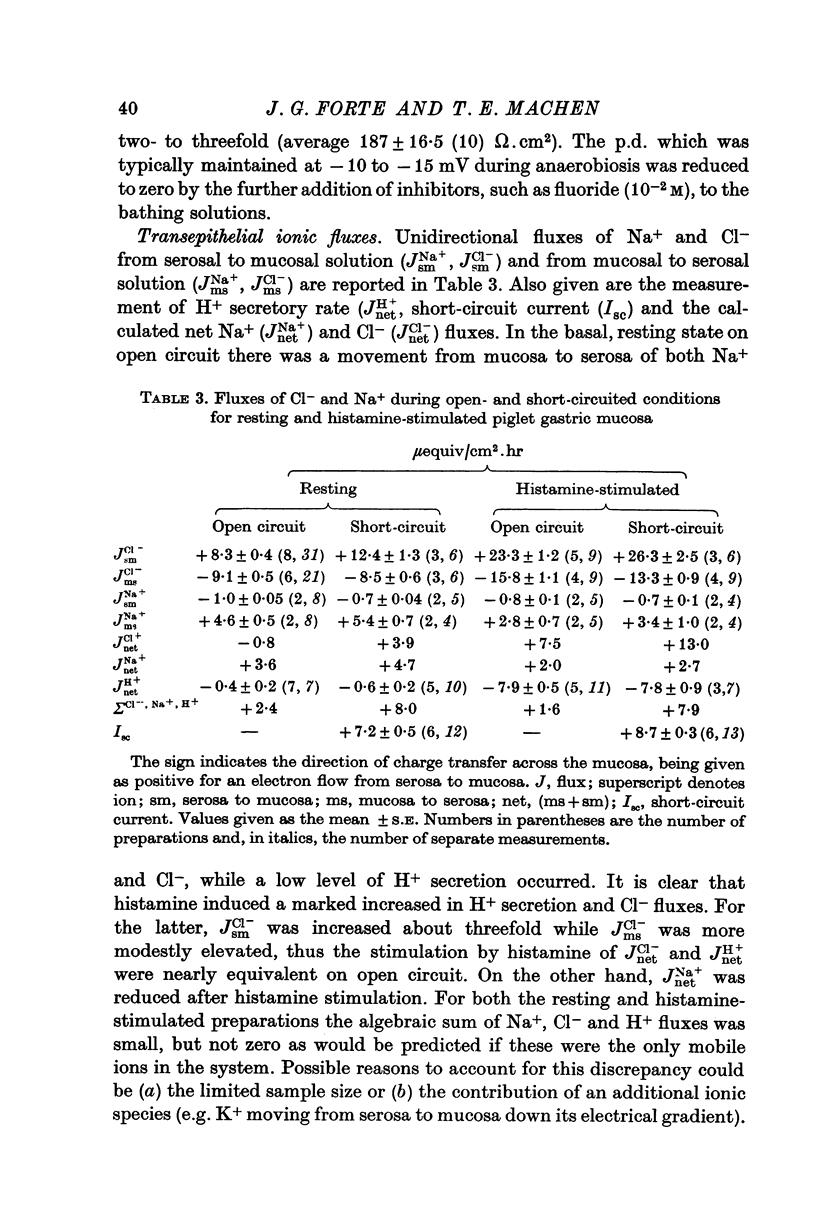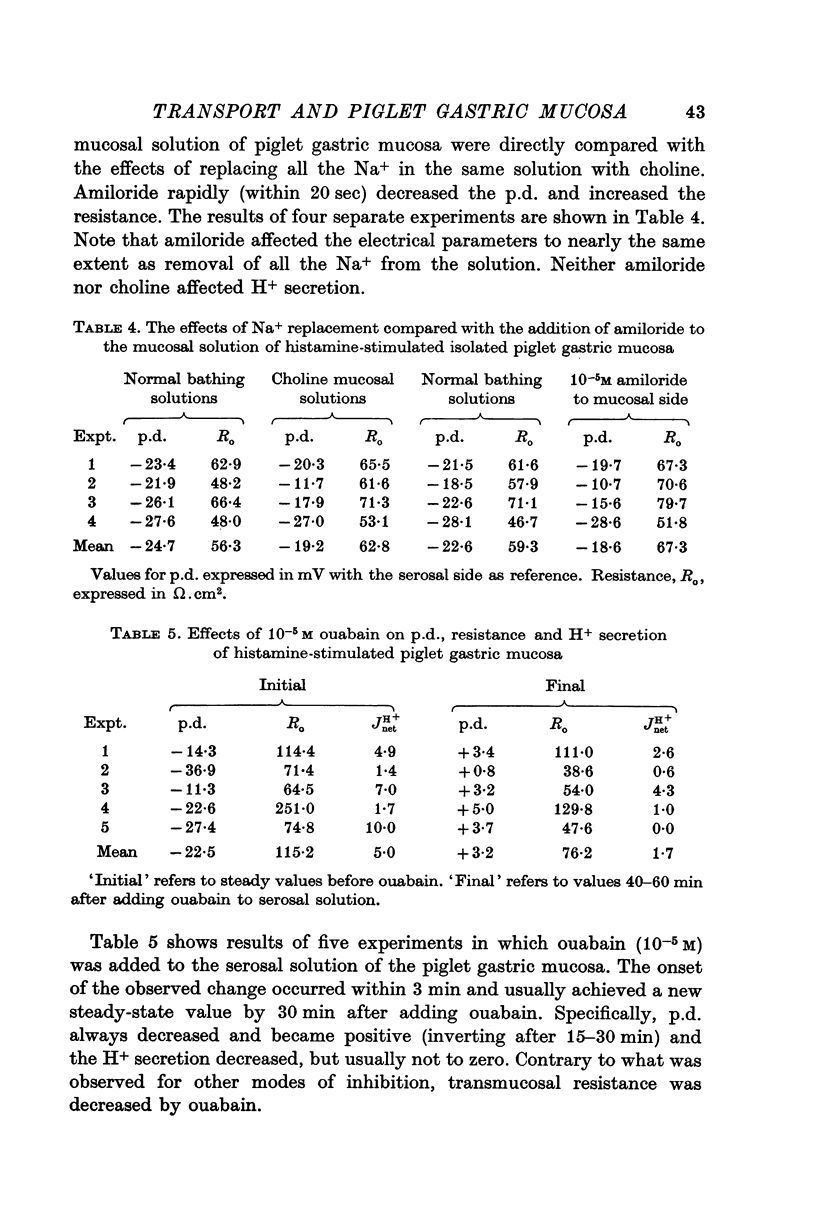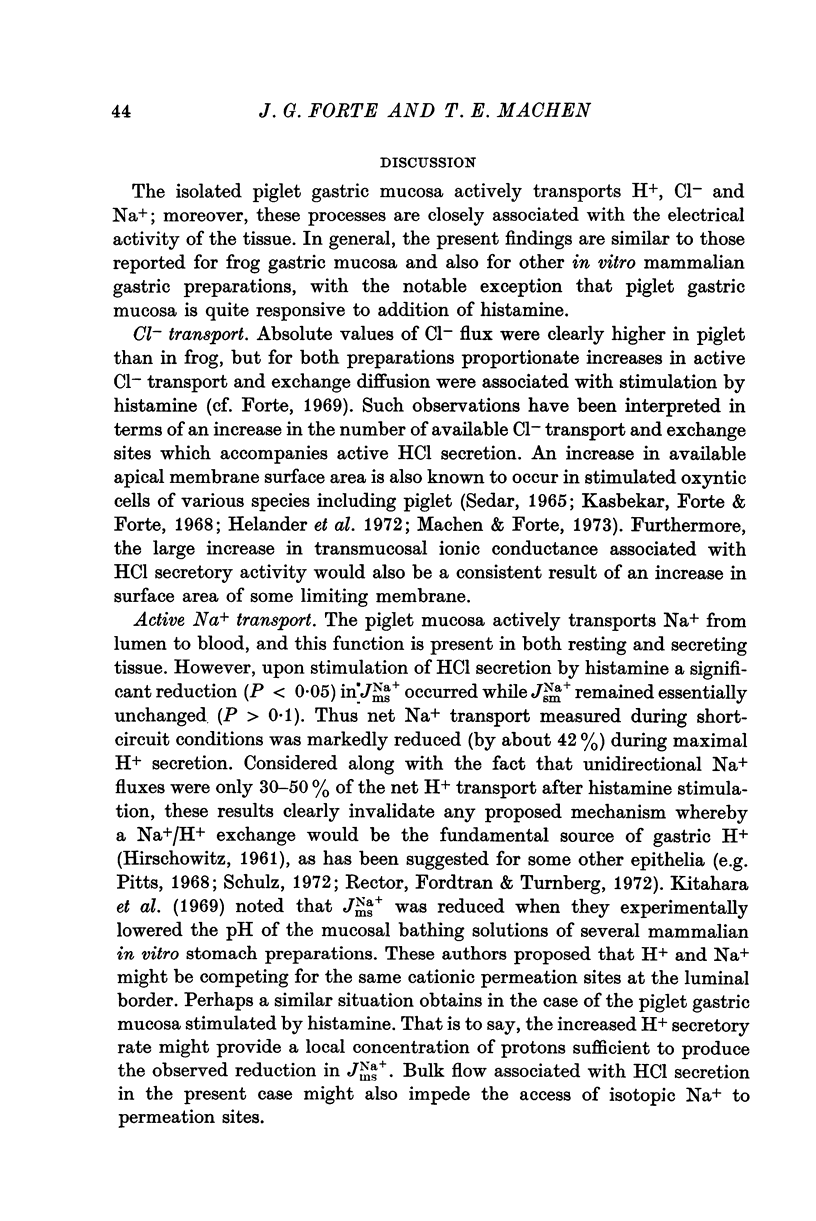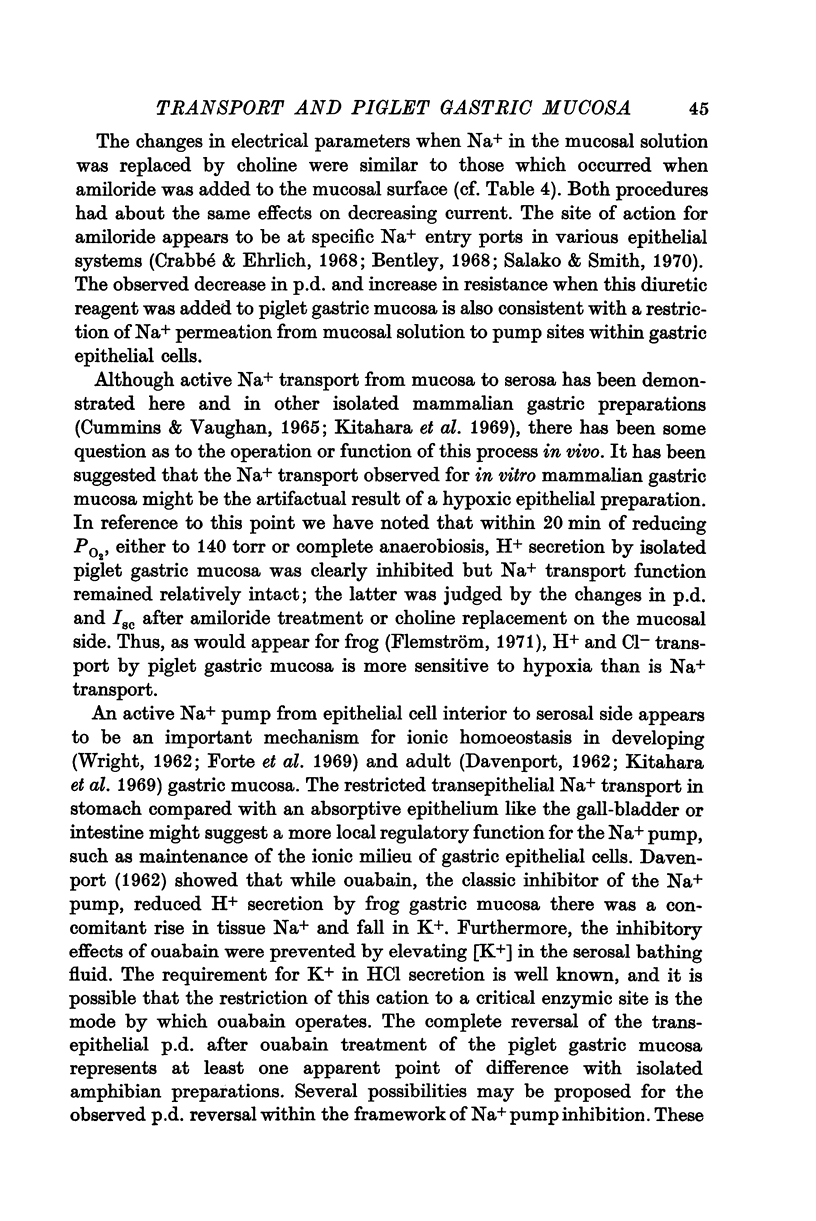Abstract
1. Gastric mucosae were isolated from piglets (0-5 days old) and mounted in a chamber where electrical properties and secretory function could be measured. Unlike many previously reported mammalian in vitro preparations, pig gastric mucosae were stable and physiologically responsive for many hours after isolation. 2. With similar Ringer solutions bathing both surfaces, the isolated piglet gastric mucosa maintained a p.d. with the mucosal surface 30-35 mV negative with respect to the serosal surface. Limitation of access of Na+ from the mucosal bathing solution to the tissue (e.g. replacement of Na+ on mucosal side with choline or treatment with 10- minus 5 M amiloride) produced a decrease in p.d. and increase in mucosal resistance consistent with an hypothesis of Na+ transport from mucosa to serosa. 3. Isotopic flux measurements (36Cl and 24Na) and net H+ secretory rate were performed during open and short-circuit conditions, while the tissue was at rest and after stimulation of HCl secretion by 6 times 10- minus 5 M histamine. Up to 90% of the respective short-circuit current for resting or secreting mucosae was accounted for as the algebraic sum of Cl minus, H+ or Na+ fluxes. 4. The net transport of Na+ which occurred from mucosa to serosa during rest (ca. 4-7 muequiv/cm2.hr) was somewhat reduced during HCl secretion (ca. 2-7 muequiv/cm2.hr). This active transport of Na+ was more resistant to anaerobiosis than was H+ or Cl minus transport. 5. An active transport component of Cl minus from serosa to mucosa was clearly demonstrable in the non-secreting preparations (ca. 3-9 muequiv/cm2.hr). Active Cl minus transport was stimulated three- to fourfold after H+ secretion was stimulated by histamine. Anaerobiosis promptly reduced Cl minus and H+ transport. An exchange diffusion component was demonstrated for Cl minus which appeared to be prominent during H+ secretory activity and was considerably diminished in resting mucosae. 6. Large changes in mucosal resistance were associated with conditions of rest, histamine stimulation and anaerobic conditions; mean values were 113, 74 and 197 omega.cm2, respectively. Electrical conductance of the isolated gastric mucosa was due primarily to partial ionic conductance of Cl minus (60-65%) and Na+ (10-15%). The partial conductance of H+ was extremely low. The observed increase in tissue conductance associated with H+ secretory activity and the changes in the long-time constant p.d. transient to a current pulse are discussed in terms of the relative contribution of the serosal and mucosal plasma membrane surfaces.
Full text
PDF


















Selected References
These references are in PubMed. This may not be the complete list of references from this article.
- BORNSTEIN A. M., DENNIS W. H., REHM W. S. Movement of water, sodium, chloride and hydrogen ions across the resting stomach. Am J Physiol. 1959 Aug;197:332–336. doi: 10.1152/ajplegacy.1959.197.2.332. [DOI] [PubMed] [Google Scholar]
- Baer J. E., Jones C. B., Spitzer S. A., Russo H. F. The potassium-sparing and natriuretic activity of N-amidino-3,5-diamino-6-chloropyrazinecarboxamide hydrochloride dihydrate (amiloride hydrochloride). J Pharmacol Exp Ther. 1967 Aug;157(2):472–485. [PubMed] [Google Scholar]
- Barry P. H., Hope A. B. Electroosmosis in membranes: effects of unstirred layers and transport numbers. I. Theory. Biophys J. 1969 May;9(5):700–728. doi: 10.1016/S0006-3495(69)86413-1. [DOI] [PMC free article] [PubMed] [Google Scholar]
- Bentley P. J. Amiloride: a potent inhibitor of sodium transport across the toad bladder. J Physiol. 1968 Mar;195(2):317–330. doi: 10.1113/jphysiol.1968.sp008460. [DOI] [PMC free article] [PubMed] [Google Scholar]
- CUMMINS J. T., VAUGHAN B. E. IONIC RELATIONSHIPS OF THE BIOELECTROGENIC MECHANISM IN ISOLATED RAT STOMACH. Biochim Biophys Acta. 1965 Jan 25;94:280–292. doi: 10.1016/0926-6585(65)90032-4. [DOI] [PubMed] [Google Scholar]
- Crane E. E., Davies R. E., Longmuir N. M. Relations between hydrochloric acid secretion and electrical phenomena in frog gastric mucosa. Biochem J. 1948;43(3):321–336. doi: 10.1042/bj0430321. [DOI] [PMC free article] [PubMed] [Google Scholar]
- DAVENPORT H. W. Effect of ouabain on acid secretion and electrolyte content of frog gastric mucosa. Proc Soc Exp Biol Med. 1962 Jul;110:613–615. doi: 10.3181/00379727-110-27595. [DOI] [PubMed] [Google Scholar]
- DAVENPORT H. W. SODIUM AND POTASSIUM IN CANINE GASTRIC MUCOSA AND SMOOTH MUSCLE. Am J Physiol. 1963 Sep;205:413–416. doi: 10.1152/ajplegacy.1963.205.3.413. [DOI] [PubMed] [Google Scholar]
- FORTE J. G., ADAMS P. H., DAVIES R. E. Source of the gastric mucosal potential difference. Nature. 1963 Mar 2;197:874–876. doi: 10.1038/197874a0. [DOI] [PubMed] [Google Scholar]
- FORTE J. G., DAVIES R. E. RELATION BETWEEN HYDROGEN ION SECRETION AND OXYGEN UPTAKE BY GASTRIC MUCOSA. Am J Physiol. 1964 Jan;206:218–222. doi: 10.1152/ajplegacy.1964.206.1.218. [DOI] [PubMed] [Google Scholar]
- Ferreira K. T. Anionic dependence of sodium transport in the frog skin. Biochim Biophys Acta. 1968 Jun 11;150(4):587–598. doi: 10.1016/0005-2736(68)90048-5. [DOI] [PubMed] [Google Scholar]
- Forte J. G., Forte T. M., Machen T. E. Histamine-stimulated hydrogen ion secretion by in vitro piglet gastric mucosa. J Physiol. 1975 Jan;244(1):15–31. doi: 10.1113/jphysiol.1975.sp010782. [DOI] [PMC free article] [PubMed] [Google Scholar]
- Forte J. G., Limlomwongse L., Kasbekar D. K. Ion transport and the development of hydrogen ion secretion in the stomach of the metamorphosing bullfrog tadpole. J Gen Physiol. 1969 Jul;54(1):76–95. doi: 10.1085/jgp.54.1.76. [DOI] [PMC free article] [PubMed] [Google Scholar]
- Forte J. G. The effect of inhibitors of HCl secretion on the unidirectional fluxes of chloride across bullfrog gastric mucosa. Biochim Biophys Acta. 1968 Jan 3;150(1):136–145. doi: 10.1016/0005-2736(68)90017-5. [DOI] [PubMed] [Google Scholar]
- Forte J. G. Three components of Cl flux across isolated bullfrog gastric mucosa. Am J Physiol. 1969 Jan;216(1):167–174. doi: 10.1152/ajplegacy.1969.216.1.167. [DOI] [PubMed] [Google Scholar]
- HARRIS J. B., EDELMAN I. S. CHEMICAL CONCENTRATION GRADIENTS AND ELECTRICAL PROPERTIES OF GASTRIC MUCOSA. Am J Physiol. 1964 Apr;206:769–782. doi: 10.1152/ajplegacy.1964.206.4.769. [DOI] [PubMed] [Google Scholar]
- HEINZ E., DURBIN R. P. Studies of the chloride transport in the gastric mucosa of the frog. J Gen Physiol. 1957 Sep 20;41(1):101–117. doi: 10.1085/jgp.41.1.101. [DOI] [PMC free article] [PubMed] [Google Scholar]
- HIRSCHOWITZ B. I. Electrolytes in human gastric secretion. Observations and a theory. Am J Dig Dis. 1961 Mar;6:199–228. doi: 10.1007/BF02283955. [DOI] [PubMed] [Google Scholar]
- Hogben C. A., Brandes M., Stavens B. The electrophysiological response of the dogfish gastric mucosa to extracellular potassium. Comp Biochem Physiol A Comp Physiol. 1972 May 1;42(1):153–168. doi: 10.1016/0300-9629(72)90375-1. [DOI] [PubMed] [Google Scholar]
- JANACEK K. A TRANSIENT ELECTROPHYSIOLOGICAL PHENOMENON IN FROG SKIN. Physiol Bohemoslov. 1963;12:349–357. [PubMed] [Google Scholar]
- KOEFOED-JOHNSEN V., USSING H. H. The nature of the frog skin potential. Acta Physiol Scand. 1958 Jun 2;42(3-4):298–308. doi: 10.1111/j.1748-1716.1958.tb01563.x. [DOI] [PubMed] [Google Scholar]
- Kasbekar D. K., Forte G. M., Forte J. G. Phospholipid turnover and ultrastructural changes in resting and secreting bullfrog gastric mucosa. Biochim Biophys Acta. 1968 Aug;163(1):1–13. doi: 10.1016/0005-2736(68)90026-6. [DOI] [PubMed] [Google Scholar]
- Kidder G. W., 3rd, Rehm W. S. A model for the long time-constant transient voltage response to current in epithelial tissues. Biophys J. 1970 Mar;10(3):215–236. doi: 10.1016/S0006-3495(70)86295-6. [DOI] [PMC free article] [PubMed] [Google Scholar]
- Kitahara S., Fox K. R., Hogben C. A. Acid secretion, Na+ absorption, and the origin of the potential difference across isolated mammalian stomachs. Am J Dig Dis. 1969 Apr;14(4):221–238. doi: 10.1007/BF02235951. [DOI] [PubMed] [Google Scholar]
- LEFEVRE M. E., GOHMANN E. J., Jr, REHM W. S. AN HYPOTHESIS FOR DISCOVERY OF INHIBITORS OF GASTRIC ACID SECRETION. Am J Physiol. 1964 Sep;207:613–618. doi: 10.1152/ajplegacy.1964.207.3.613. [DOI] [PubMed] [Google Scholar]
- Nagel W., Dörge A. Effect of Amiloride on sodium transport of frog skin. I. Action on intracellular sodium content. Pflugers Arch. 1970;317(1):84–92. doi: 10.1007/BF00586701. [DOI] [PubMed] [Google Scholar]
- Noyes D. H., Rehm W. S. Unstirred-layer model for the long time-constant transient voltage response to current in epithelial tissue. J Theor Biol. 1971 Jul;32(1):25–45. doi: 10.1016/0022-5193(71)90133-0. [DOI] [PubMed] [Google Scholar]
- Pacifico A. D., Schwartz M., MacKrell T. N., Spangler S. G., Sanders S. S., Rehm W. S. Reversal by potassium of an effect of barium on the frog gastric mucosa. Am J Physiol. 1969 Mar;216(3):536–541. doi: 10.1152/ajplegacy.1969.216.3.536. [DOI] [PubMed] [Google Scholar]
- REHM W. S. Electrical resistance of resting and secreting stomach. Am J Physiol. 1953 Mar;172(3):689–699. doi: 10.1152/ajplegacy.1953.172.3.689. [DOI] [PubMed] [Google Scholar]
- Rehm W. S. Ion permeability and electrical resistance of the frog's gastric mucosa. Fed Proc. 1967 Sep;26(5):1303–1313. [PubMed] [Google Scholar]
- Rehm W. S., Shoemaker R. L., Sanders S. S., Tarvin J. T., Wright J. A., Jr, Friday E. A. Conductance of epithelial tissues with particular reference to the frog's cornea and gastric mucosa. Exp Eye Res. 1973 May 10;15(5):533–552. doi: 10.1016/0014-4835(73)90066-3. [DOI] [PubMed] [Google Scholar]
- Salako L. A., Smith A. J. Changes in sodium pool and kinetics of sodium transport in frog skin produced by amiloride. Br J Pharmacol. 1970 May;39(1):99–109. doi: 10.1111/j.1476-5381.1970.tb09559.x. [DOI] [PMC free article] [PubMed] [Google Scholar]
- Sedar A. W. Fine structure of the stimulated oxyntic cell. Fed Proc. 1965 Nov-Dec;24(6):1360–1367. [PubMed] [Google Scholar]
- Sernka T. J., Hogben C. A. Active ion transport by isolated gastric mucosae of rat and guinea pig. Am J Physiol. 1969 Nov;217(5):1419–1424. doi: 10.1152/ajplegacy.1969.217.5.1419. [DOI] [PubMed] [Google Scholar]
- Solberg L. A., Jr, Forte J. G. Differential effects of--SH reagents on transport and electrical properties of gastric mucosa. Am J Physiol. 1971 May;220(5):1404–1412. doi: 10.1152/ajplegacy.1971.220.5.1404. [DOI] [PubMed] [Google Scholar]
- Spangler S. G., Rehm W. S. Potential responses of nutrient membrane of frog's stomach to step changes in external K+ and Cl- concentrations. Biophys J. 1968 Nov;8(11):1211–1227. doi: 10.1016/S0006-3495(68)86551-8. [DOI] [PMC free article] [PubMed] [Google Scholar]
- USSING H. H., ZERAHN K. Active transport of sodium as the source of electric current in the short-circuited isolated frog skin. Acta Physiol Scand. 1951 Aug 25;23(2-3):110–127. doi: 10.1111/j.1748-1716.1951.tb00800.x. [DOI] [PubMed] [Google Scholar]
- WRIGHT G. H. Net transfers of water, sodium, chloride and hydrogen ions across the gastric mucosa of the rabbit foetus. J Physiol. 1962 Sep;163:281–293. doi: 10.1113/jphysiol.1962.sp006974. [DOI] [PMC free article] [PubMed] [Google Scholar]


